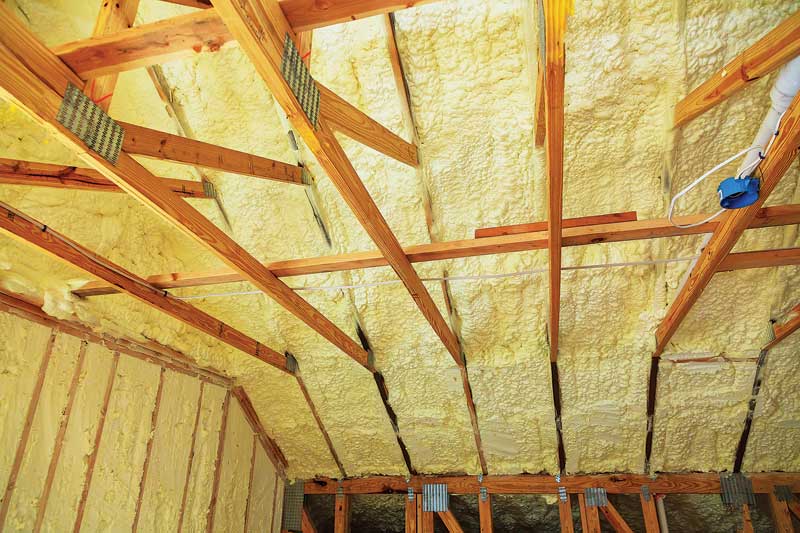The attic is the best place to start improving your home's insulation, but inadequate insulation can lead to significant heat loss and air leakage. While many thermal protection materials are available, spray foam insulation stands out for its efficiency, durability, and ease of installation.
To insulate your attic with spray foam insulation, you must prepare the attic rafters and floor by sealing gaps and removing any existing insulation. Afterward, you should conduct an energy audit to determine the insulation needs. Then, calculate the required thickness and start applying the spray foam.
In the following article, we'll guide you through insulating your attic with our Vega Bond spray foam insulation. So keep reading to take your attic to the next level and maximize your home's energy efficiency.
How to Spray Foam an Attic to Improve Efficiency: Step-by-Step Instructions
There are 5 key steps you need to follow to insulate your attic with our Vega Bond spray foam insulating material.
Materials Needed:
- Vega Bond V200 or V600 Spray Foam Insulation
- High-quality vapor barrier paint
- Protective gears
- Safety goggles
- Disposable coveralls
- Nitrile gloves
- Respirator mask
- Utility knife or foam saw
Step 1: Prepare Attic Rafters and Floor
Clear out any unnecessary items from your attic rafters and floor before applying the insulation. Remove any old insulation if present, as it may hamper the effectiveness of newer options. Fill up any small cracks or holes in the attic using weatherstripping or caulk to prevent air leakage.
Additionally, you should thoroughly clean the attic before starting the insulation process. This will help create a clean and stable surface for the foam insulation to adhere to.
Step 2: Conduct an Energy Audit
After preparing your attic rafters and floor, conduct an energy audit. This will help you identify areas of your attic that may lack insulation or have air leaks.
Start by checking for existing insulation, caulking, and weatherstripping. Inspect the attic thoroughly, using an infrared camera or visual inspection, to identify potential air leaks. Look for areas where insulation may be missing or damaged.
Step 3: Choose the Right Type of Spray Foam
After conducting an energy audit, you can select the appropriate type of spray foam insulation to insulate your attic. There are two main types of spray foam insulation to choose from: open-cell foam and closed-cell foam.
Open-cell foam is ideal for thicker applications, as it expands more and provides a better air seal. It's also more cost-effective compared to closed-cell foam.
Conversely, closed-cell foam has a higher R-value per inch, making it more suitable for areas requiring a higher insulation level. It's denser and provides a stronger barrier against moisture and air infiltration.
Step 4: Measure and Calculate for Insulation Thickness
To accurately determine the insulation thickness needed for your attic, measure the square footage of your attic using a measuring tape. Start by measuring the length and width of your attic. Multiply these two numbers together to find the square footage.
Now, check the manufacturer's instructions in your selected product to determine the ideal insulation thickness for your attic. Calculate the amount of Vega Bond spray foam needed for your attic based on the recommended thickness.
Step 5: Apply Vega Bond Spray Foam to Attic Surfaces
To effectively insulate your attic, apply Vega Bond spray foam (V200 or V600, which one you selected) to its surfaces.
Shake the Can of Vega Bond spray foam well before use. Hold the can upright and spray a thin, even foam layer onto the surfaces, starting from the bottom and working your way up. Make sure to cover all areas, including corners and edges.
Allow the foam to expand and cure according to the manufacturer's instructions. Once cured, the spray foam will create a barrier that helps prevent air leakage and provides insulation.
What to Consider When Insulating an Attic with Spray Foam?
Several important factors must be considered when insulating your attic area with spray foam:
1. Attic Conditions
Before insulating your attic with spray foam, consider the current conditions of the space and address any existing issues.
Start by assessing the state of your attic and checking for any existing insulation, air leaks, or potential moisture problems. If insulation is present, carefully remove it and fill any gaps or holes causing air leakage.
2. Local Building Codes
To ensure compliance with local building codes, consider the following factors when protecting your attic with spray foam.
- Check the requirements for the specific type of insulation you plan to use. Some areas may restrict certain materials or require specific fire safety ratings.
- Find out the proper R-value for your climate zone. Building codes often specify the minimum insulation level needed to achieve energy efficiency.
- Be aware of any ventilation requirements. Proper attic ventilation prevents moisture buildup and maintains a healthy indoor environment.
- Follow installation guidelines and obtain any necessary permits. Following local building codes will ensure a safe and effective insulation job.
3. Long-Term Maintenance
Ensure proper long-term maintenance of your attic insulation with spray foam by regularly inspecting and addressing ventilation, wear, and damage.
Ventilation is essential to prevent moisture buildup, which can lead to mold and rot. Check for blocked vents or obstructions in your attic to ensure proper airflow. Also, inspect the insulation for wear or damage, such as cracks or gaps. These can diminish the insulation's effectiveness and should be repaired promptly.
Invest in Vega Bond Spray Foam Insulation for Energy Efficiency
Insulating your attic space with our Vega Foam Insulation like wrapping your home in a cozy blanket, keeping it warm and protected from the outside elements.
So, don't let your attic be a cold, forgotten space. Visit our official website to acquire the product needed to transform your attic into a warm, cozy space.




